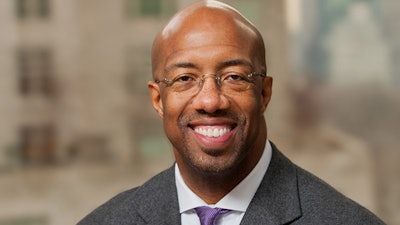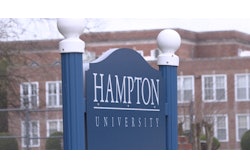 Dr. Michael Sorrell, the president of Paul Quinn College, an HBCU in Texas
Dr. Michael Sorrell, the president of Paul Quinn College, an HBCU in Texas
“I wish we would see investment from a broader lens and understand what could be done if the same people didn’t give the same money to the same institution,” said Dr. Michael J. Sorrell, the president of Paul Quinn College, one of the nation's historically Black colleges and universities (HBCUs). About 80% of Paul Quinn students are Pell Grant recipients.
Sorrell was one of the speakers on a panel co-hosted by Rutgers University’s Center for Minority Serving Institutions (CMSI) and the Samuel DeWitt Proctor Institute for Leadership, Equity, and Justice. The other panelists included two researchers of philanthropy in higher education as well as Dr. Rowena Tomaneng, president of San Jose City College (SJCC), another MSI.
“I have several thousand students from the poorest neighborhoods in San Jose, so the work we do is really about lifting students out of generational poverty,” said Tomaneng.
About 40% of SJCC students are Latinx and 30% identify as Asian American.
“With the pandemic, I have witnessed many students and their families losing employment, facing food insecurity and other affordability issues,” said Tomaneng. “So, philanthropy has been at the center of the work I’ve been doing this past year.”
Yet Tomaneng said that as a community college in Silicon Valley, SJCC often battles against stigmas that can be attached to the institution and its students. She has been trying to change the narrative on the potential of her students and the value of their degree. Still, fundraising can be an uphill climb for many MSIs like SJCC.
Virgil Parker, one of the panel’s moderators and an HBCU graduate, cited stark disparities in higher education philanthropy. In fiscal year 2018, Harvard University raised $1.42 billion. From this past year alone, Howard University, one of the most well-known HBCUs, has reported $140 million in philanthropic investments. And that number exceeded Howard’s fundraising total over a decade, between 2010 and 2019.
“So, if you see that large of a discrepancy between a leading MSI and its peers, just imagine how other MSIs may suffer without having that kind of philanthropy,” said Parker.
Sorrell added what that discrepancy can mean for the day-to-day operations of an MSI like Paul Quinn.
“When we talk about philanthropy, I want to first make sure that people understand that when you are at resource-scarce institutions, you learn to be creative with the funding you get,” he said. “To hear those numbers at Harvard, it’s outstanding. Because I wonder how many lives you could have pulled out of poverty with those resources.”
Sorrell also cautioned against an over-reliance on individual philanthropists and foundations. The multimillion-dollar gifts from MacKenzie Scott to MSIs garnered widespread media coverage. Yet he pointed out that it is unclear what happens next.
“We’ve looked at ways to build models that allow us to be less dependent on philanthropy because we just can’t depend on it,” said Sorrell. “This is a great season for philanthropy at MSIs, but we don’t know how long that will last.”
At Paul Quinn, Sorrell mentioned they’ve used funding they do have to renovate campus, to make changes the community can see. Still, the larger problem remains in how philanthropy often leaves out MSIs. Part of that issue is a false narrative on who gives and who doesn’t, said Dr. Noah Drezner, professor of higher and postsecondary education at Columbia University.
“When you look at the research, alumni of color and communities of color are more generous to higher education and to philanthropic organizations generally than white counterparts,” said Drezner. “But when you look at absolute dollars, the headlines go to white donors because that is where the most wealth is. So part of the problem is focusing on those absolute dollars.”
Drezner added that research has shown that racial justice has become more of a motivating factor behind why people give. To him, that presents an opportunity for MSIs and Predominantly White Institutions (PWIs) to tap more into underrepresented communities who are just as if not more generous than their white, male counterparts, which are the historically dominant donors.
“I aspire in my research to change these narratives, to look at people of color as givers through all of their institutions, from churches to clubs to literary societies, it’s everywhere,” said fellow panelist Dr. Tyrone McKinley Freeman, an associate professor of philanthropic studies at Indiana University’s Lilly Family School of Philanthropy.
Like Drezner, Freeman has studied racial inequities in higher education philanthropy. However, he noted that parts of academia still tend to not see philanthropy research as critical. That trend has been shifting recently, though not quickly enough to Drezner.
“We’re seeing much more of this research on philanthropy at MSIs and HBCUs, but not enough,” he said. “There are so many questions that can still be asked and answered.”
Sorrell added that one key point in this discrepancy discussion is that HBCUs have been historically excluded from building wealth to the level of their PWI peers.
“The disparity exists because HBCUs were founded to educate freed slaves,” he said. “Forget about amassing wealth and property. These people weren’t even allowed to read and write for the entirety of their American experience.”
But vast parts of the country grew wealthy from the slave trade, including some PWIs.
“It takes us longer to amass the wealth because we were never intended to have the wealth because the system of wealth others have was built on our Black and brown backs,” said Sorrell.
When building relationships with donors, Sorrell mentioned that it is critical for the philanthropists or foundations to understand this history of HBCUs.
“We have to first find people who would be amenable to our histories and not be embarrassed or ashamed,” he said. “Because in Texas, we’re dealing with people trying to erase the entire history of slavery. It’s really hard to engage with those kinds of people about philanthropy at MSIs. You can approach them, but that’s a very hard sell.”
Freeman also suggested encouraging donors that do give to MSIs to look at long-term estate planning and renewing their contributions. The long history of these institutions needing to make up for lost money, he said, means it is important to take a long view of philanthropy.
“I would also say, don’t be a white savior philanthropist with too many strings attached to a gift,” said Drezner. “Give your philanthropy as a partnership. Allow the institutions to lead in that partnership. They are going to know where the dollars are needed most.”
Looking ahead, Sorrell hopes for change soon despite limited resources at MSIs.
“Don’t assume that HBCU presidents aren’t seeking philanthropic dollars and that they aren’t aggressively out doing so,” said Sorrell. “But our jobs require us to do more than fundraise. That’s a luxury that my non-HBCU peers and PWIs tend to have that quite frankly I don’t have.”
Rebecca Kelliher can be reached at [email protected]
















